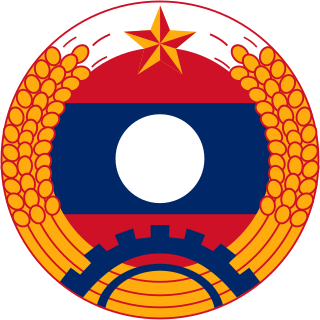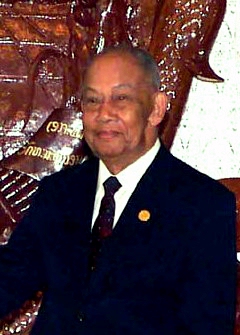
The politics of the Lao People's Democratic Republic takes place in the framework of a one-party parliamentary socialist republic. The only legal political party is the Lao People's Revolutionary Party (LPRP). The head of state is President Thongloun Sisoulith, who is also the LPRP general secretary, making him the supreme leader of Laos. The head of government is Prime Minister Sonexay Siphandone.

The Lao People's Armed Forces, is the armed forces of the Lao People's Democratic Republic and the institution of the Lao People's Revolutionary Party, who are charged with protecting the country.

Kaysone Phomvihane was the first leader of the Communist Lao People's Revolutionary Party from 1955 until his death in 1992. After the Communists seized power in the wake of the Laotian Civil War, he was the de facto leader of Laos from 1975 until his death. He served as the first Prime Minister of the Lao People's Democratic Republic from 1975 to 1991 and then as the second President from 1991 to 1992.

The Lao People's Revolutionary Party (LPRP) is the founding and sole ruling party of the Lao People's Democratic Republic. The party's monopoly on state power is guaranteed by Article 3 of the Constitution of Laos, and it maintains a unitary state with centralised control over the economy and military.

General Khamtai Siphandone is a Laotian politician who was Chairman of the Lao People's Revolutionary Party from 24 November 1992 to 21 March 2006 and President of Laos from 24 February 1998 to 8 June 2006, when he was replaced by Choummaly Sayasone. He was a member of the Communist Party of Indochina in 1954 and a member of the Central Committee of the Lao People's Revolutionary Party in 1956.

Nouhak Phoumsavanh or Phoumsavan was a longtime Pathet Lao revolutionary and communist party official who was the 3rd President of Laos from 1992 to 1998.

Laos elects a legislature nationally and the public also participates in the election of village heads. The National Assembly has 164 members, elected for five year terms.

The Prime Minister of the Lao People's Democratic Republic, formerly the chairman of the Council of Government of the Lao People's Democratic Republic, is the head of government of Laos. The highest position in the government, they direct the country's executive branch. The prime minister is accountable to the president, the National Assembly and the country's only legal party: the Lao People's Revolutionary Party (LPRP). The current prime minister is Sonexay Siphandone, who was elected in 2022.

Lieutenant General Choummaly Sayasone is a Laotian politician who was General Secretary of the Lao People's Revolutionary Party (LPRP) and President of Laos from 2006 to 2016.

The National Assembly is the highest power organisation of Laos. It is the only branch of government in Laos, and per the principle of unified power, all state organs are subservient to it. The National Assembly meets in Vientiane.

Laos–Vietnam relations refers to the current and historical relationship between the Lao People's Democratic Republic and Socialist Republic of Vietnam. The relationship, although seen as better than Vietnam-Cambodia ties, are still prescient with negative feelings, especially as Vietnam and China vie for influence in Laos.

The Constitution of Laos specifies the functions and powers of the government of the Lao People's Democratic Republic, and defines the rights and duties of Laotian citizens. The constitution was adopted on August 14, 1991, sixteen years after the 1975 establishment of the Republic, a period during which the country functioned without a written constitution or published penal and criminal codes. It consists of a Preamble and Articles, and legally establishes a set of authorities that resemble the traditional differentiation among executive, legislative, and judicial branches of government.
Asang Laoly is a retired Lao politician, Major General, and member of the Lao People's Revolutionary Party (LPRP). While he was the Deputy Prime Minister of Laos from 2002 to 2016, he also held a number of leadership positions in both the government and in LPRP.
The 9th Politburo of the Lao People's Revolutionary Party (LPRP), officially the Political Bureau of the 9th National Congress of the Lao People's Revolutionary Party, was elected in 2011 at the 1st Plenary Session of the 9th Central Committee.
The 9th Congress of the Lao People's Revolutionary Party (LPRP) was held in Vientiane from 17–21 March 2011. The congress occurs once every five years. A total of 576 delegates represented the party's 191,700 card-carrying members.

The National Congress of the Lao People's Revolutionary Party is the party's highest decision-making body. The LPRP has convened 11 congresses since its foundation in 1955, and eight since taking power in 1975. According to the party rules, the party congress is to be convened by the LPRP Central Committee (CC) every fifth year. It functions as a forum that approves party policy, is empowered to amend the party's charter and program, and elects the Central Committee. The party leadership, through the Political Report of the Central Committee, briefs the party on its work in the period since its last congress, and sets out future goals for the period in between the next congress.

The 11th Central Committee was elected at the 11th National Congress of the Lao People's Revolutionary Party on 15 January 2021, and is composed of 71 ordinary members and ten substitutes. As an institution, the Central Committee is the party's highest decision-making body between convocations of the National Congress, which convenes every fifth year. Since the LPRP has a monopoly on state power in Laos, the Central Committees formulates policies which the state implements. In between plenary sessions of the 11th Central Committee the 11th Politburo, is the party's highest decision-making body.

Kaysone Phomvihane Thought is a political ideology that builds upon Marxism–Leninism and Ho Chi Minh Thought with the political philosophy developed by Kaysone Phomvihane, the first leader of the Communist Lao People's Revolutionary Party (LPRP). It was first formalised by the LPRP at its 10th National Congress, held in 2016. The ideology includes views on the basic issues of the Laotian Revolution, specifically the application and development of Marxism–Leninism to the material conditions of Laos. The contents of Kaysone Phomvihane Thought was codified and developed by the LPRP with help from the Communist Party of Vietnam.
Saysomphone Phomvihane is a Laotian politician and member of the Lao People's Revolutionary Party (LPRP). He is the son of former LPRP General Secretary Kaysone Phomvihane and Thongvin Phomvihane. He served as Chairman of the Central Committee of the Lao Front for National Construction. He currently serves as President of the National Assembly.

Sonexay Siphandone is a Laotian politician and member of the Lao People's Revolutionary Party (LPRP). He is the son of former LPRP Chairman Khamtai Siphandone and brother of Viengthong Siphandone. On 30 December 2022, parliament approved Sonexay Siphandone as Prime Minister.












